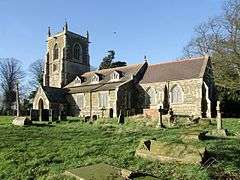Mavis Enderby
| Mavis Enderby | |
 Church of St Michael, Mavis Enderby |
|
 Mavis Enderby |
|
| OS grid reference | TF361663 |
|---|---|
| – London | 115 mi (185 km) S |
| District | East Lindsey |
| Shire county | Lincolnshire |
| Region | East Midlands |
| Country | England |
| Sovereign state | United Kingdom |
| Post town | Spilsby |
| Postcode district | PE23 |
| Police | Lincolnshire |
| Fire | Lincolnshire |
| Ambulance | East Midlands |
| EU Parliament | East Midlands |
| UK Parliament | Louth and Horncastle |
|
|
Coordinates: 53°10′37″N 0°02′08″E / 53.177043°N 0.035595°E
Mavis Enderby is a hamlet and civil parish in the East Lindsey district of Lincolnshire, England. It lies in the Lincolnshire Wolds, 4.5 miles (7 km) east from Horncastle. The population is included in the civil parish of Raithby by Spilsby.
History
An alternative spelling may be "Malvyssh Enderby", as seen in a legal record in 1430, where the plaintiffs are the executors of a man whose surname is Enderby, and the defendant lives in Malvyssh Enderby.[1]
Literary references
Mavis Enderby had a peal of bells named after it, called The Brides of Enderby,[2] which is mentioned in Jean Ingelow's poem The High Tide on the Coast of Lincolnshire 1571: in the poem the ringing of the Enderby bells is the generally recognised signal of approaching danger to the neighbouring countryside: "Came down that kindly message free, the Brides of Mavis Enderby".
An extract from the poem is at the head of Rudyard Kipling's short story, At the Pit's Mouth.[3]
Douglas Adams used the name "Mavis Enderby" in his spoof The Meaning of Liff dictionary "of things that there aren't any words for yet". Adams assigned meanings to placenames based on what he imagined them to mean, Mavis Enderby becoming "The almost-completely-forgotten girlfriend from your distant past for whom your wife has a completely irrational jealousy and hatred".
St Michael's Church

The parish church is dedicated to St Michael. Dating from the 14th and 15th centuries, the church was restored by James Fowler 1875. The tower was rebuilt by C. Hodgson Fowler in 1894. The exterior is of squared greenstone rubble, with limestone ashlar dressings. It has Welsh and Westmorland slate roofs with decorative tiled ridges. The church interior comprises a nave, western tower, south aisle and porch, and a chancel. At the threshold of west door to the tower is set part of a coped or round-topped 11th century Saxon grave slab, possibly placed here in 1894. The churchyard has the remains of a 14th-century churchyard cross.[4]
In the porch is a Norman pillar piscina, a stone basin for draining water used in the rinsing of the chalice. The churchyard has a sundial erected by a former rector.
See also
References
- ↑ Plea Rolls of the Court of Common Pleas; National Archives; CP 40 / 677; http://aalt.law.uh.edu/AALT1/H6/CP40no677/bCP40no677dorses/IMG_1275.htm; 4th entry
- ↑ "The Brides of Enderby"; Enderbymuseum.ca. Retrieved 30 April 2012
- ↑ "At the Pit's Mouth - from Under the Deodars". telelib.com. Retrieved 30 October 2016.
- ↑ Historic England. "Church of Saint Michael (354049)". PastScape. Retrieved 28 November 2009.
External links
 Media related to Mavis Enderby at Wikimedia Commons
Media related to Mavis Enderby at Wikimedia Commons